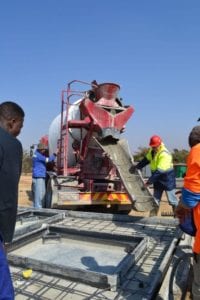Delegates at this year’s Readymix Conference by Sarma were able to witness first-hand how tilt-up construction can be used to speed up the delivery of houses or infrastructure such as hospitals or police stations.
Tilt-up construction is an established type of construction in which floors and exterior walls are cast in concrete and lifted into place once they have been sufficiently cured. The walls are then simply fastened and roofing and other elements are affixed. While this building practice is used extensively on shopping centres in South Africa, it is only recently that contractors and Government departments have begun looking at the method for quick construction of housing developments.Faster, simpler, stronger
Charles van Eck of Tilt-Up Construction, said the main reason that this type of construction is becoming popular is its speed of erection, as well as improved quality of construction. “There is a massive skills shortage and the quality of work and speed of delivery of standard bricks and mortar construction can no longer be guaranteed. “Tilt-up overcomes this by using moulds that simply need steel reinforcing and services (plumbing electricity) to be put in place and quality readymix to be poured in and settled. Construction can be done within a small footprint with walls cast on top of each other using bond breakers between each layer.“Within a week or two (depending on curing times) the walls can then be erected, roof put on and services connected. The construction can be semi-industrialized and manufactured in a production line-type process. That means you can pour walls for several houses at a time and while they are curing you can be doing foundations for the next batch and erecting others etc,” says Charles.
He says the benefits include high quality finish, speed of construction, super-strong, hard-wearing / durable walls, cost effectiveness and efficient use of labour. The process also requires less specialised skills and consists of set a perimeter formwork on a sacrificial slab, applying bond breaker, fixing reinforcing, positioning and securing lifting bracing inserts, casting and floating panels, curing, erecting and temporarily bracings the structure and finally connect into the unified structure. Charles concludes that it can be cast to suit needs including multi-storey for varsity hostels, mines, affordable living etc. “Tilt-up has evolved to meet shortfalls and delivers a high quality product that is gaining acceptance throughout the country and is destined to become a building method of choice.”







